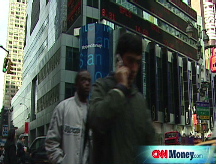$250 billion, but not much to lend
As more banks sign up for the government's capital plan, it is becoming increasingly clear that not all of them will use the funds to open up the credit markets.
NEW YORK (CNNMoney.com) -- Billions of dollars will soon be pouring into coffers of banks across the country as part of the historic bailout package announced last month.
What banks do with those funds remains a little less certain.
Ultimately, regulators hope that the $250 billion they plan to inject into the nation's banks and thrifts by investing in their stocks will spur lenders to dole out loans to consumers and businesses in need of credit.
Some banks will do just that - most likely the larger institutions that were part of the original group of nine that signed up for the program earlier this month, including Citigroup (C, Fortune 500), Bank of America (BAC, Fortune 500) and Goldman Sachs (GS, Fortune 500).
On Monday, more than dozen regional banks joined their ranks including such companies as KeyCorp. (KEY, Fortune 500), Regions Financial (RF, Fortune 500), Valley National Bancorp (VLY) and Capital One Financial Corp. (COF, Fortune 500) But as the universe of recipients expands, so will the uses for the government capital.
"My guess is we will see a litany of things done with it," said Anthony Davis, senior research analyst at Stifel Nicolaus & Co. "I think it will vary a bit with each company."
Davis said that beyond using the money to make loans, banks could pay down debt. Some may also pursue acquisitions.
Last week, Pittsburgh-based PNC (PNC, Fortune 500) announced plans to buy embattled lender National City on the same day it said it would sell a stake to the U.S. government for $7.7 billion.
Some industry experts, and even regulators themselves, have hinted that the U.S. banking landscape is overpopulated and needs to slim down either through failures or consolidation.
But with the bailout funded by taxpayer dollars, a string of similar acquisitions done with government capital could not only draw the ire of taxpayers but the scrutiny of lawmakers as well.
Regulators in Europe have set fairly clear rules about what banks can and cannot do with their newfound capital. Top U.S. officials have been more liberal with the terms of their capital program.
"That seems to be a repugnant thought in Congress, but the fact of the matter is it is hard to give these guys capital and say 'You can't do this and you can't do that,' " said Davis.
Lawmakers acknowledged that fact at a Senate Banking committee hearing last week. However, many experts say that more rigid guidelines are needed.
But Peyton Green, senior analyst at FTN Midwest who covers a number of regional banks, said that more bank consolidation is indeed one of the government's goals.
"They want three things to happen - to get credit issues resolved sooner rather than later, for stronger players to take out weaker players and to have those banks that don't want to grow by acquisition to grow organically," Green said.
At the same time, the government's capital plan could certainly give some lenders a new lease on life. Banks that get a capital infusion may now be less vulnerable to a takeover themselves.
"It puts you in stronger position, but it probably doesn't completely insulate you," said John Jay, of the financial services research and advisory firm Aite Group.
As for the central issue of lending, some better-positioned banks are already providing funds for commercial real estate or business loans because of attractive credit spreads on those loans.
But by and large, banks remained scared about loosening credit standards - especially at a time when the U.S. economy appears to be headed into what could be a painful recession.
"It is going to be a function of each individual bank and individual circumstances," said Stifel's Davis. "What they do with [government capital] will be driven by what they need to address."
--An earlier version of this story incorrectly stated that Baltimore-based Provident Bancshares was among a group of banks that was involved in the government's capital program. The company, however, has not officially agreed to participate and said that decision would be up to its board of directors. ![]()


